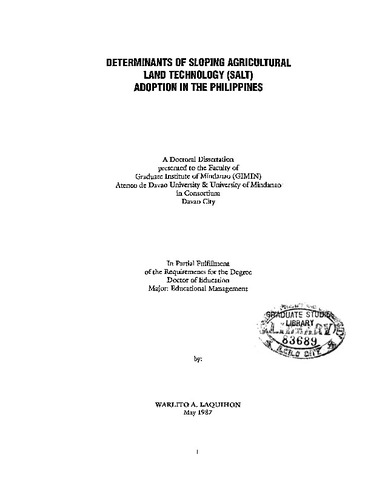Determinants of Sloping Agricultural Land Technology (SALT) adoption in the Philippines

Page views
5,180Date
1987Auteur
Thesis Adviser
Defense Panel Chair
Share
Metadata
Afficher la notice complète
Résumé
Sloping Agricultural Land Technology (SALT) is one variant of agroforestry developed by and practiced at the Mindanao Baptist Rural Life Center (MBRLC) in Bansalan, Davao del Sur since 1978, SALT has four-fold objectives: to minimize soil erosion, to restore soil fertility, to produce food sustainability, and to generate decent incomes for upland families (Watson and Laquihon, 1985).
"To achieve its objectives, this upland farming system grows diversified food crops (both short and permanent crops) between thick contour rows of leguminous shrubs and trees spaced 3 to 4 meters apart."
When these leguminous shrubs and trees (preferably a combination of Leucaena, Gliricidia, Sesbania, Flemingia, Rensonii, etc.) are 1.5 to 2 meters tall, they are cut to about 40 centimeters from the ground. Their trimmings provide excellent mulch, green manure, and organic materials for the crops in the alleyway. Meanwhile, their roots and stems effectively hold the soil in place.
More importantly, the crops grown in the alleys provide the family with adequate food and income. Presently, the average annual net income of the 9-year-old SALT demonstration fa rm in Kinuskusan, Bansalan, Davao del Sur, is P14,000 per hectare. This net income is over nine times higher than the average net income of the traditional upland farming system which is only P1,600.00 per hectare per year.
Statement of the Problem
SALT is found technically feasible and economically viable at the MBRLC experimental fields since its development in 1978. However, it seems that the technology is not so socially acceptable, especially during the first five years of its existence. The adoption rate of SALT by the upland farmers leaves much to be desired. Watson and Laquihon (1981) noted:
"Thousands of farmers have visited our demonstration SALT. During such visits, some become so excited that they hopped from one alley to the next without waiting for the tour guide. To our knowledge, of the thousands who had visited our SALT farm, no farmer criticized the system; but neither did many return home to establish a SALT project."
Interestingly, however, at the middle of the year 1982 many national and even international organizations and their respective farmer-cooperators started to adopt SALT (Table 1). In fact, Rev. Watson has gained international recognition for his pioneering role in SALT and was conferred the prestigious “Ramon Magsaysay Foundation Award for International Understanding” in 1985 for encouraging adoption of SALT.
An important question should then be asked: What makes upland farmers adopt technologies like SALT? Studies proposing to seek answers to this and related questions concerning upland development are timely and in order. Hence, this research.
The problem of this study, therefore was focused on the inquiry on what are the determinants of SALT adoption in the Philippines according to the viewpoints of its adopters.
More importantly the study focused on the following questions:
1. What is the demographic and socio-cultural profile of the SALT adopters?
2. How were the determinants for SALT adoption formulated?
3. How did the Luzon, Visayas and Mindanao groups vary in their perception of the rank in importance of the determinants?
4. How did the Luzon, Visayas and Mindanao groups vary in the number and rank of SALT practices adopted?
5. How did the SALT adoption affect the income of the adopters?
6. What relevant problems affecting SALT adoption did SALT adopters encounter?
Description
Abstract and introduction
Suggested Citation
Laquihon, W. A. (1987). Determinants of Sloping Agricultural Land Technology (SALT) adoption in the Philippines (Unpublished Doctoral dissertation). Graduate Institute of Mindanao (GIMIN,) Ateneo de Davao University and University of Mindanao, Davao City.
Type
DissertationDepartment
Graduate Institute of Mindanao (GIMIN)Degree
Doctor of Education major in Educational ManagementShelf Location
GSL Theses 338.160599 L319
Physical Description
xvii, 79 leaves
Collections
- Dissertations [3]

